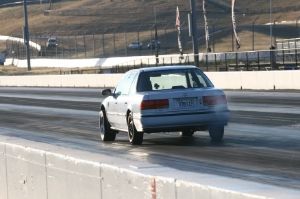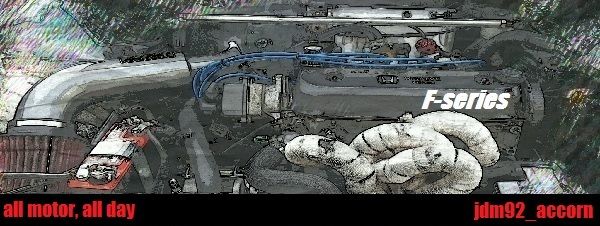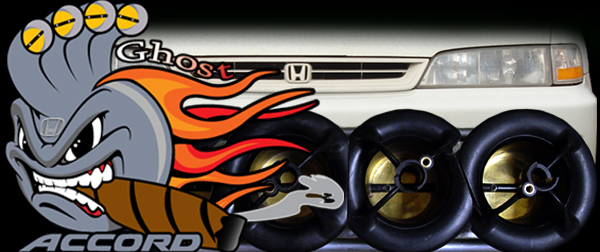I have an untouched F22a1 head/block in my '93 and an untouched F23a1 head/block in my '99. Both engines are near 300k miles, and I would have to agree that the F22a1 is more consistent. I know exactly how this engine will respond to me. There is something less predictable about the F23a1 when under power.
Announcement
Collapse
No announcement yet.
jdm92_accorn : 1992 Accord LX
Collapse
X
-
Sleeving, custom pistons and some h22 rods. Stroke is a big deal for power in any car, especially n/a street cars. Look at all the n/a 4cyl cars now. Almost all the 2.3-2.5 cars without turbos are long rod, long stroke to give a broader powerband and believe it or not, better fuel economy in a heavy chassis. My f23 setup averaged 27mpg city, my f22 with the same setup as my original f23 build that made 206whp, gets around 21mpg.
Comment
-
Do you think a f22 would still be as consistent/smooth as usual when built to that level?Originally posted by jdm92_accorn View PostSleeving, custom pistons and some h22 rods. Stroke is a big deal for power in any car, especially n/a street cars. Look at all the n/a 4cyl cars now. Almost all the 2.3-2.5 cars without turbos are long rod, long stroke to give a broader powerband and believe it or not, better fuel economy in a heavy chassis. My f23 setup averaged 27mpg city, my f22 with the same setup as my original f23 build that made 206whp, gets around 21mpg.
Comment
-
Similar but not the same. Anytime you modify an engine from it's factory configuration, you're going to change its characteristics. I do think the f22 at 87mm x 95mm would be just as powerful, if not more, and rev higher with less effort. The main difference would be the torque would be at a higher rpm. The key selling point to the f23 is $ per HP. It was instantly 30+whp and 25+wtq over my f22 for the same cost as another f22.
Comment
-
Yeah, your research is swaying me towards swapping and building a f23. Get that extra torque for daily driveability. Then just try to work out whatever makes it run rougher than the f22.Originally posted by jdm92_accorn View PostSimilar but not the same. Anytime you modify an engine from it's factory configuration, you're going to change its characteristics. I do think the f22 at 87mm x 95mm would be just as powerful, if not more, and rev higher with less effort. The main difference would be the torque would be at a higher rpm. The key selling point to the f23 is $ per HP. It was instantly 30+whp and 25+wtq over my f22 for the same cost as another f22.
I figure that would be easier/less expensive than building up the 22.
Again, man, thank you so much for this thread and all your research time. It's invaluable.
Comment
-
Until you finally figure out that it is the extra 5mm of stroke and longer rods that is the reason for the inconsistency of the F23 power band. Then it would have been easier to start with the 95mm F22 and go with larger bore vs longer stroke for added displacement.Originally posted by Lucien View PostYeah, your research is swaying me towards swapping and building a f23. Get that extra torque for daily driveability. Then just try to work out whatever makes it run rougher than the f22.
I figure that would be easier/less expensive than building up the 22.
Again, man, thank you so much for this thread and all your research time. It's invaluable.
Not that this is the reason for the F23 flat spots... I'm just saying.
A square or over square engine is a happy engine!
Comment
-
Originally posted by GhostAccord View PostUntil you finally figure out that it is the extra 5mm of stroke and longer rods that is the reason for the inconsistency of the F23 power band. Then it would have been easier to start with the 95mm F22 and go with larger bore vs longer stroke for added displacement.
Not that this is the reason for the F23 flat spots... I'm just saying.
A square or over square engine is a happy engine!

Comment
-
The f23 has a consistent power band. The inconsistency in his case is obd1 vs obd2. In my case it was oil temps and crankcase ventilation. The whole square engine is a happy engine has merit but isn't always true. An engine that is improperly balanced at say 90mm x 90.7mm would be terrible compared to a fully balanced 88x100mm setup. Rod to stroke ratio and piston speeds are what's really important to watch. The f22b bottom I run was meant for higher revs so it seems to be slightly more ballanced that a f22a. Its also about 10yrs newer. The f23 is 86mm x 97mm with 141mm rods vs the f22a/b at 85mm x 95mm with a 141.5mm rod. This puts the f23 at a 1.45 r/s and the f22 at a 1.49 r/s. That will cause roughly a 2% increase in piston speed. Anytime you increase piston speed it increases friction, friction creates heats and accelerated wear and tear. From a dd standpoint the f23 bottom end is a great bang per buck upgrade.
Comment
-
So going by this, a rebuild or a low mileage engine is the best bet for reliability? That being said, do you think that a "low mileage" JDM engine is a good thing to get as a bottom end? The JDM short block I have that I'm going to swap my current engine with had "210" PSI on all 4 cylinder (it was written on the timing cover). I'm wondering if its gonna be healthy and reliable. You said something about engine oil temps do you think I should install a stock oil cooler?Originally posted by jdm92_accorn View PostThe f23 has a consistent power band. The inconsistency in his case is obd1 vs obd2. In my case it was oil temps and crankcase ventilation. The whole square engine is a happy engine has merit but isn't always true. An engine that is improperly balanced at say 90mm x 90.7mm would be terrible compared to a fully balanced 88x100mm setup. Rod to stroke ratio and piston speeds are what's really important to watch. The f22b bottom I run was meant for higher revs so it seems to be slightly more ballanced that a f22a. Its also about 10yrs newer. The f23 is 86mm x 97mm with 141mm rods vs the f22a/b at 85mm x 95mm with a 141.5mm rod. This puts the f23 at a 1.45 r/s and the f22 at a 1.49 r/s. That will cause roughly a 2% increase in piston speed. Anytime you increase piston speed it increases friction, friction creates heats and accelerated wear and tear. From a dd standpoint the f23 bottom end is a great bang per buck upgrade.Last edited by Mishakol129; 04-15-2014, 03:58 PM.“Speed has never killed anyone. Suddenly becoming stationary, that's what gets you.”
― Jeremy Clarkson
Very first tear down and rebuild. vvv
http://www.cb7tuner.com/vbb/showthread.php?t=193755"]http://www.cb7tuner.com/vbb/showthread.php?t=193755"]http://www.cb7tuner.com/vbb/showthread.php?t=193755
Current Build, F23 block F22b dohc head:
http://www.cb7tuner.com/vbb/showthread.php?t=203144
Comment
-
lol..... yeah yeah.... any engine that has not been properly balanced would be a nightmare in the end. I was talking all things being equal on build quality and the balance side of things!Originally posted by jdm92_accorn View PostThe f23 has a consistent power band. The inconsistency in his case is obd1 vs obd2. In my case it was oil temps and crankcase ventilation. The whole square engine is a happy engine has merit but isn't always true. An engine that is improperly balanced at say 90mm x 90.7mm would be terrible compared to a fully balanced 88x100mm setup. Rod to stroke ratio and piston speeds are what's really important to watch. The f22b bottom I run was meant for higher revs so it seems to be slightly more ballanced that a f22a. Its also about 10yrs newer. The f23 is 86mm x 97mm with 141mm rods vs the f22a/b at 85mm x 95mm with a 141.5mm rod. This puts the f23 at a 1.45 r/s and the f22 at a 1.49 r/s. That will cause roughly a 2% increase in piston speed. Anytime you increase piston speed it increases friction, friction creates heats and accelerated wear and tear. From a dd standpoint the f23 bottom end is a great bang per buck upgrade.
It's not that the F22b bottom end was better balanced than the F22A. If you were to take them apart and inspect them. I think you would be surprised as to what you would find. They are identical..... In the case of the F22B the cylinder head components were designed to perform at a higher RPM. Similar to the H23 and H22 vs the F22A/B, it's not balancing or clearances in the bottom end that increase the engines RPM ranges. It's more the head and it's components and the stroke!
Look at any of the longer stroke Honda engines... the red line is usually lower than any engine of the same displacement with a shorter stroke. The engines are both balanced properly and clearances are pretty much the same. it's the stroke/piston speed that makes the difference. So you agree with me in the end, we are saying the same thing.
A fully balanced square or over square engine is a happy engine, as they both have a better R/S and slower piston speeds than an under square (stroked engine). Last edited by GhostAccord; 04-15-2014, 04:40 PM.
Last edited by GhostAccord; 04-15-2014, 04:40 PM.
Comment
-
Lol, I was just making sure you stay on your toes ghost. A square or over square is ideal for performance and longevity. I personally will always love strokers, then again I know their faults and I'm willing to accept them. Stroker motors don't live as long at higher revs. They are prone to more oiling and temprature issues aswell. In my opinion, I think strokers offer more fun in a street car. With that being said, gearing and or forced induction on short stroke engines can be a more reliable and just as fast. I'll always build all motor cars as my passion no matter what is faster. I learned long ago, there will always be someone faster than you, building a car to be faster than somebody else will leave you broke, unsatisfied and full of regret. If I build my car to make me happy and never for anyone else it'll be money well spent.
Comment
-
Originally posted by jdm92_accorn View PostI learned long ago, there will always be someone faster than you, building a car to be faster than somebody else will leave you broke, unsatisfied and full of regret. If I build my car to make me happy and never for anyone else it'll be money well spent.
I loved my 383 cid stroked '77 Camaro. It was by far the funnest car I have ever built.
Comment





Comment